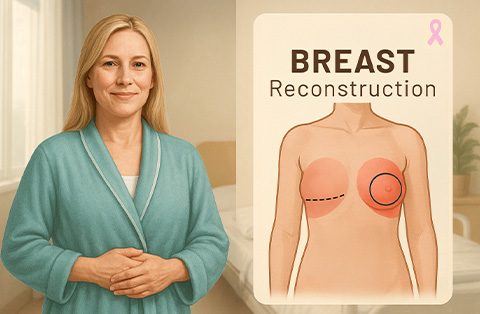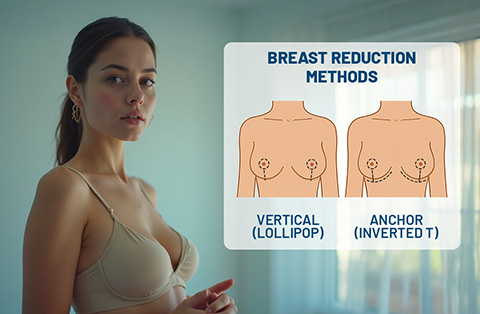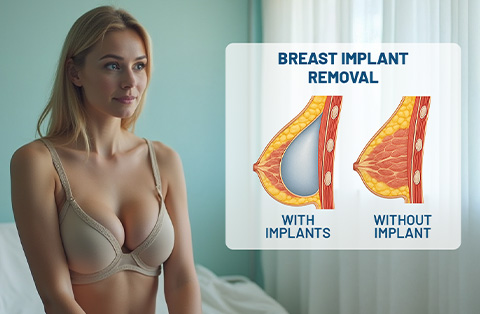Enhancing body image through breast augmentation has become a common aesthetic procedure worldwide. Women who have undergone breast augmentation may wonder, “Do breast implants need to be replaced?”
The answer isn’t as straightforward as one might expect. In this comprehensive guide, we will dive deep into this topic, demystifying various aspects related to breast implants, from types to longevity, reasons for replacement, signs of rejection, and more.
Our aim is to empower you with the necessary knowledge to make informed decisions about your body and health.
What is a Breast Implant?
Breast implants are medical prosthesis used to augment, reconstruct, or create the physical form of breasts. They come in various sizes, shapes, and materials, offering diverse options to cater to individual needs and preferences.
Types of Breast Implants:
There are primarily two types of breast implants:
• Saline
• Silicone
Each has its own advantages and drawbacks, which will be detailed further.
Why Should You Consider Getting Your Breast Implants Replaced?
Breast implants may require replacement for a variety of reasons. Some of these include changing the size of implants, drooping of breasts, capsular contracture, rupturing or deflating of implants, rippling of implants, position change, and unhappiness with the augmentation results.
• Changing the Size of Implants: Some women decide to have their breast implants replaced to alter the size of their breasts. This could be because they initially opted for a smaller size and later wish to have larger breasts, or they might feel that their initial choice was too large and they would now prefer a more modest size.
• Drooping of Breasts: As we age, our bodies naturally change. Skin loses elasticity and gravity takes its toll, which can lead to sagging or drooping breasts – even those with implants. Sometimes, to maintain the desired look and feel, a woman might decide to have her implants replaced or complement the implants with a breast lift.
• Capsular Contracture: This is when the natural scar tissue around a breast implant contracts, causing the breast to feel hard or look unnatural. It can be painful in some cases. The severity of capsular contracture varies greatly, but severe cases often necessitate the removal or replacement of the implant.
• Rupturing or Deflating of Implants: Although breast implants are designed to be durable and long-lasting, they can sometimes rupture or deflate. This can be due to an injury, wear and tear over time, or a flaw in the implant itself. In the case of a rupture or deflation, the implant should be replaced.
• Rippling of Implants: Rippling happens when the implant begins to fold or wrinkle under the skin, creating an uneven or rippled appearance on the breast surface. This might be more common in women with little natural breast tissue or when saline implants have been used. Replacement with a different type or size of implant can address this issue.
• Position Change: Over time, implants can shift position, which might alter the appearance of the breasts. This could be due to several factors, such as the natural aging process, weight fluctuations, or complications from the original surgery. A replacement surgery can correct the positioning of the implants.
• Unhappiness with the Augmentation Results: Lastly, some women may simply be dissatisfied with the results of their initial breast augmentation. This could be due to a variety of reasons, including an unsatisfactory size, shape, or feel. In these cases, replacing the implants can help achieve the desired aesthetic outcome.
Symptoms of Your Body Rejecting Breast Implants:
While rare, some individuals may experience symptoms signaling the body’s rejection of the implant. These include discomfort and pain, abnormal breast implant shape, asymmetry between breasts, a deflated or ruptured breast implant, and more.
• Discomfort and Pain: When your body is rejecting a breast implant, one of the first and most common signs you may experience is discomfort or pain. This can vary from a constant dull ache to sharp, shooting pains. It’s important to differentiate post-operative pain, which is normal in the days following surgery, from ongoing pain or discomfort that persists or appears long after the healing process.
• Abnormal Breast Implant Shape: Changes in the shape of the implant could be a sign that your body is rejecting it. The implant may appear distorted, hard, lumpy, or misshapen. This could be due to a variety of reasons, including capsular contracture or a ruptured implant.
• Asymmetry Between Breasts: Asymmetry, where one breast looks different from the other in terms of size, shape or position, could be a symptom of implant rejection. It might also indicate complications such as implant displacement or capsular contracture.
• Deflated or Ruptured Breast Implant: If an implant ruptures, the saline or silicone filling can leak into the body. Saline implants will deflate and noticeably change in size, while silicone implants might cause breast pain or changes in breast shape. Any changes in the size or shape of your breasts should be evaluated by a healthcare professional immediately.
• Breast Tenderness: While some tenderness can be expected after surgery, persistent or new tenderness can be a sign of rejection or an infection.
• Implant Sitting Either Too Low or Too High: This may indicate that the pocket created for the implant during surgery was made too large or not large enough, or it could mean that the implant has moved since the operation.
These symptoms can range from mild to severe and should not be ignored. If you’re experiencing any of these symptoms after a breast augmentation, it’s crucial to reach out to your surgeon or healthcare provider for evaluation.
Do You Have to Replace Breast Implants Every 10 Years?
Not necessarily. However, implants aren’t lifetime devices. The need for replacement depends on individual factors and the quality of the implant.
What Percentage of Breast Implants Rupture?
Breast implant rupture rates depend on various factors, including the type of implant and the duration since implantation.
How Do You Know if a Breast Implant Ruptures?
Implant ruptures may present as a change in breast size, shape, or feel. Pain, lumps, swelling, or changes in sensation can also signal a rupture.
What Happens if You Don’t Replace Breast Implants?
Ignoring the need to replace an aged or damaged implant can lead to complications such as leakage, ruptures, or the development of capsular contracture.
What Happens to Breast Implants Over Time?
Breast implants can undergo changes over time, often influenced by aging, gravity, hormonal fluctuations, and weight changes.
What to Expect with Implant Removal and Replacement?
Removing or replacing breast implants is a surgical procedure. It requires careful planning and recovery time, much like the initial augmentation.
How to Increase Implant Longevity?
Proper care, regular check-ups, and maintaining a stable weight can enhance the longevity of your breast implants
Conclusion
Breast implants may need to be replaced for a variety of reasons. Awareness about their lifespan and potential complications can help you take timely action, ensuring optimal health and satisfaction with your body image.






